IN THIS ISSUE
- Taking stock of bees
- Pollinator projects for you
- Gray squirrel survival skills
- Anhinga vs. catfish: Round II
 Fishing line later removed from a bluebird nest box at DNR offices (Anna Yellin/DNR)
Leave no line behind. If you’re an angler, adopting that practice can be a lifesaver for wildlife.
Fishing line that’s not discarded properly can pose problems for animals, and particularly birds. Entanglement can mean stress, injury and even death.
One incident that ended well involved a long piece of fishing line that bluebirds used in their nest at DNR Social Circle offices. Wildlife biologist Anna Yellin spotted the line poking out of the nest box, feared the parents or chicks would become tangled, discussed what to do with DNR Program Manager and ornithologist Dr. Bob Sargent, and then worked with another employee to carefully remove the line.
“It was an awfully big piece for such a little bird!” Yellin said.
The timing was right. The female had been incubating the eggs long enough that the brief disturbance didn’t prompt her to abandon the nest. And from the parents’ recent behavior, it seems the eggs hatched and the young fledged.
Here’s more from Audubon, plus details on recycling fishing line. (Some DNR boat ramps and Public Fishing Areas include PVC receptacles for recycling line.)
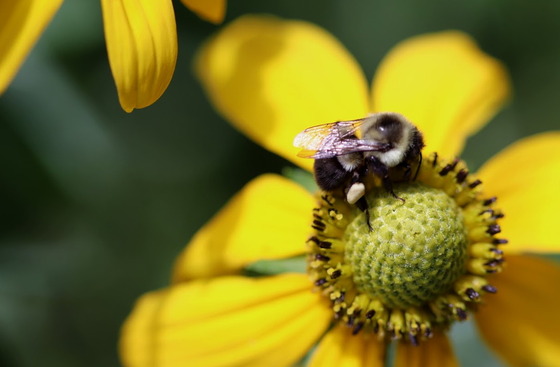 Common eastern bumblebee (Anna Yellin/DNR)
By ANNA YELLIN
Want to help pollinators but feel strapped for time? Think multi-task. A new community science project takes just a few hours but promises significant results. And you can contribute when you’re vising a state park or wildlife management area or even when helping a student with their science fair project.
This year, Georgia has joined with North Carolina, South Carolina and Tennessee in the Southeast Bumble Bee Atlas. The aim of this multi-year effort led by the Xerces Society: learn more about bumblebees.
Georgia is home to 17 species of bumblebees that help pollinate the billions of dollars in crops produced here each year. Bumblebees also play an essential role in conserving native flowering plants throughout the state. Yet little is known about the numbers of the more common bumblebees in Georgia and even less about where our rare bumblebees are busy spreading pollen this summer.
To help bumblebees, we need to know more. Queue the Bumble Bee Atlas.
How to take part: Read the general requirements at bumblebeeatlas.org. Then create an account (fast and free), log onto bumblebeeatlas.org/sebbaadopt and adopt a grid cell near you. Watch training videos. Gather the few materials – camera or cell phone, net, cooler, clear vials. And, if needed, obtain permits.
Catch and cool: Bumblebee species can be hard to identify. The catch-and-chill protocol (using vials and ice in a cooler) makes it easier to position the temporarily dormant insects for ID photos. The bees are then warmed in the sun and released.
Rookie? No worries: Knowledge about bees is not required. The website includes video, a guide and species illustrations. There also are field training opportunities. One is Aug. 12 at Panola Mountain State Park in Stockbridge (register). All photos submitted will be viewed by a Xerces Society scientist and errant IDs corrected.
Going off-grid: Although adopting a grid cell is used for this atlas, bumblebees photographed elsewhere are valuable data. Here's more on submitting such photos.
Anna Yellin is a wildlife biologist with DNR’s Wildlife Conservation Section.
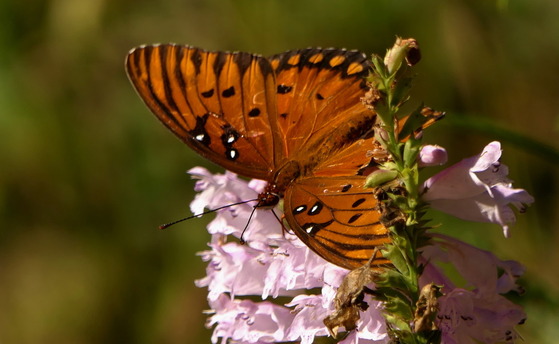 Gulf fritillary (Linda May/DNR)
MORE POLLINATOR PROJECTS
Other current citizen-science research focused on pollinators includes:
- A pilot project started this spring in Georgia and five other states is asking the public to mail butterflies, moths and skippers found dead to the U.S. Geological Survey. The effort to create a Lepidoptera research collection is aimed at helping identify contaminants and environmental factors behind declining insect populations. Learn more in this flyer and at this website.
- The annual Great Southeast Pollinator Census, created by the University of Georgia, runs Aug. 18-Sept. 15. Take part on your own or join a free guided event, such as at Alapaha's Gaskins Forest Education Center Aug. 18 and 19.
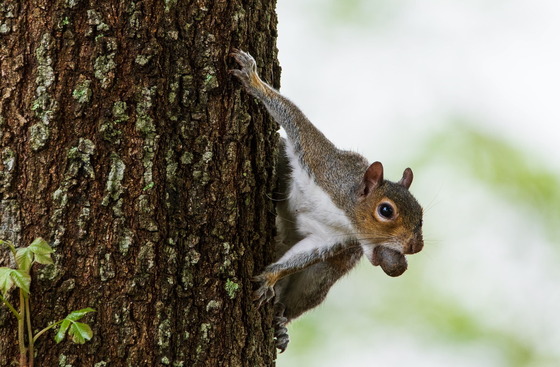 On alert, even when foraging (Sherry Rosen/GNPA)
By TERRY W. JOHNSON
Gray squirrels are a familiar sight throughout Georgia. We see them eating everything from birdseed to tomatoes in our backyard, tight-roping power lines across suburban streets and foraging for food in the woodlands that blanket much of the state.
In fact, gray squirrels are so common it’s easy to overlook the fact that each day they are threatened by a host of animals ready to make a meal of them.
But also overlooked – or not known – is that squirrels have a suite of behaviors and physical attributes they use to foil even the most skilled wild predator.
Read Terry's column exploring this common animal's uncommon survival skills.
Terry W. Johnson is a retired DNR manager and executive director of TERN, friends group of the Wildlife Conservation Section. Check out past columns and his blog. Permission is required to reprint a column.
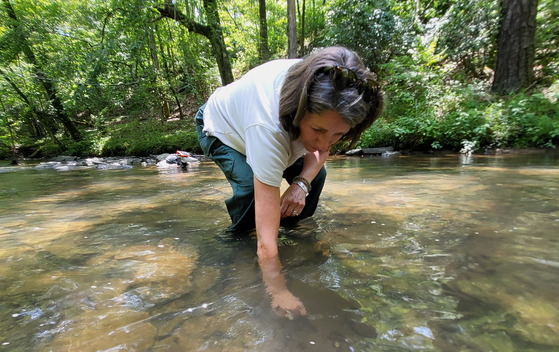 Ruth Stokes of the U.S. Forest Service releases a Coosa moccasinshell in Armuchee Creek. (Katie Owens/TNC)
Endangered Coosa moccasinshells have a fail-safe near Armuchee. DNR, the Alabama Aquatic Biodiversity Center and others released 80 of the endangered mussels this month in northwest Georgia’s Armuchee Creek. Although once found throughout the Coosa River basin, Coosa moccasinshells are now limited to about eight miles of the Conasauga River in Tennessee and Georgia and two reintroduced sites in Alabama. Releasing the mussels raised by the center serves as a cache to help maintain the species’ diversity and as a reserve if populations plummet elsewhere.
Another mollusk – the oyster – is benefiting American oystercatchers and other birds on Brunswick’s Bird Island. A project involving DNR’s Coastal Resources Division, Glovis, Georgia Ornithological Society and the National Fish and Wildlife Foundation added 320 tons of oyster shell to the dredge island’s south end, creating a large bed for live oysters and providing rich foraging areas closer to oystercatcher nests, so adults spend less time away and chicks have better odds of surviving.
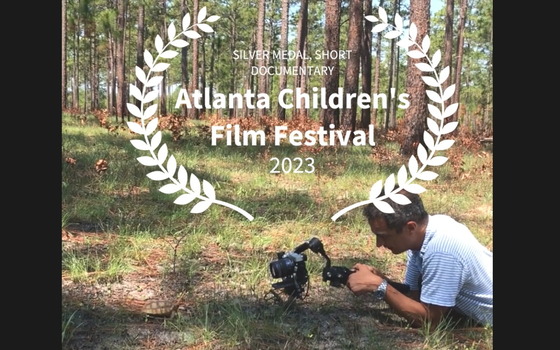 Indigo video geared to young students claims silver in children's film festival.
More kudos for “Introducing the Indigo.” The video, part of a longleaf pine-centered education campaign including a coloring book and focused on third- through fourth-graders (“All Eyes on the Indigo Snake,” November), took home silver for Short Documentary at the Atlanta Children’s Film Festival this summer.
Republicans in the U.S. House are reportedly revamping Recovering America’s Wildlife Act, with the key change centered on emphasizing wildlife habitats. It’s not clear yet how the bill will differ from a Senate version introduced this spring after bipartisan efforts to pass the legislation deemed vital to conserving more than 12,000 at-risk animal and plant species narrowly failed late last year. Georgia fact sheet and more.
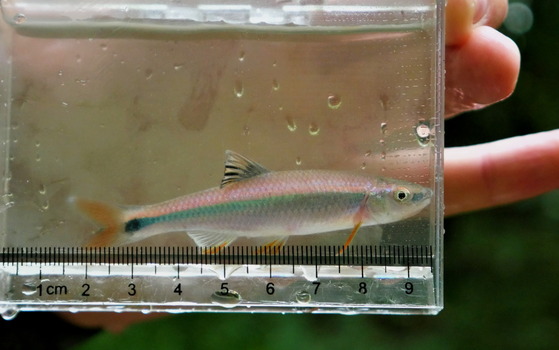 Tallapoosa shiner (Ethan Hatchett/DNR)
DNR's Stream Team and aquatics biologists recently checked the health of a Tallapoosa River stretch in northwest Georgia’s Haralson County. The crew scored vegetation, habitat and wildlife, using electrofishers that briefly stun fish and other aquatic life, to assess the waterway rich in rare species such as state-endangered lipstick darters and federally threatened finelined pocketbook mussels.
It’s not too late for current or newly graduated college students to apply for a Minorities in Natural Resources Conservation scholarship for this year’s Southeast Association of Fish and Wildlife Agencies conference. The deadline is Sept. 4; the conference, one of the region’s largest conservation-focused events, is set for Oct. 15-18 in Corpus Christi, Texas.
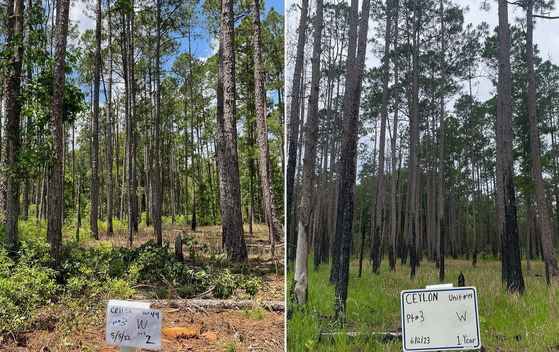 The difference fire makes: before and one-year-later photos of a Ceylon site (Dave Riddell/DNR)
Quick hits:
- Photo monitoring is documenting how the use of prescribed fire is reinvigorating habitats at Ceylon Wildlife Management Area near St. Marys, and providing reference points for restoration efforts.
- A new America’s Longleaf Restoration Initiative report highlights partner accomplishments in 2022 such as planting over 123,000 acres of longleaf pine and applying prescribed fire to more than 1.7 million acres.
- There are fewer North Atlantic right whales than thought, according to a NOAA estimate sizing the endangered whale’s population at less than 350.
- Satilla River anglers are asked to report catches a tagged blue catfish, part of a DNR study assessing the impact of these big, non-native predators in a south Georgia river already coping with invasive flathead cats.
- More than 140 of Georgia's 3,300 loggerhead sea turtle nests this year have hatched, the first wave of hatchlings that can help continue the species' recovery.
- Quotable from Limestone Valley Resource Conservation and Development Council Executive Director Stephen Bontekoe in "An endangered river worth saving," an article about the Conasauga River: “God put man on earth and said, ‘Take care of it.’ So it’s incumbent upon me, as a human being, to care for the creation we’ve been entrusted with.”
- Don’t feed bears, even unintentionally via your pets: Feed pets indoors when can and afterward securely store the bowls and any leftover food.
Names in the news: Georgia Wildlife Federation President and CEO Mike Worley received the Charlie Shaw Affiliate Partnership Award at the National Wildlife Federation’s annual meeting. The award recognizes state-level leaders who exemplify the partnership between the federation and its state affiliates. DNR game warden Keith (KP) Boatright, who works in southwest Georgia, was chosen for this year’s North American Wildlife Officers Association Region 6 Torch Award, the fourth straight year a Georgia game warden has brought home that honor. Linda May, outreach coordinator for DNR’s Wildlife Conservation Section, recently discussed how to create and maintain home-based wildlife habitats with more than 100 members of the Coweta County Backyard Association.
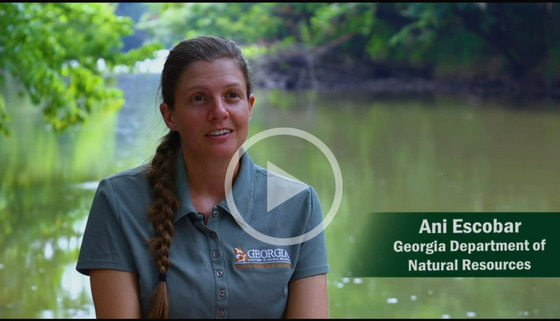 "Conserving Coosa Mussels," DNR
(audio) "Snakebite in Dogs," Snake Talk podcast with Orianne Society's Dr. Chris Jenkins
Hawk bumps osprey from perch, Savannah Bird Cam (Skidaway Island, Ga.)
Arizona's only known ocelot caught on cam, Arizona Daily Star (Tucson, Ariz.)
Virtual hearing on delayed harvest trout stream regulations, plus Q&A, DNR
"Canadian gear linked to 4 of 5 right whale entanglements this year," Connecticut Public Radio (90.5, WNPR-FM)
"UGA works to restore native plants to roadside areas," State Botanical Garden of Georgia
"Time to tag, register 'wild animal' pet reptiles in Georgia," Rome News-Tribune
(+video) "Rabid beaver attacks girl in Lanier; father kills it," CBS News and others
"DNR prepares for deer disease ahead of hunting season," Georgia Recorder
"Public land (Silver Lake WMA) hiding on edge of state is peaceful escape," Only in Your State
(+audio) "Why does rain smell?" Forbes
"Tracking algal blooms on the Georgia coast," The Current
"Birdsong Nature Center land is permanently protected," Tall Timbers
"Balls endow fish/wildlife scholarship at Ogeechee Tech," The Georgia Virtue
"Piedmont Park has wildlife; photographer good at finding it," Atlanta Journal-Constitution
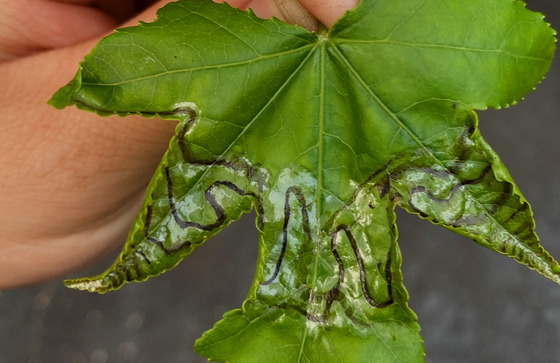 Seeing zigzags, spirals and squiggly lines beneath the surface of a leaf? The marks could be the work of leaf miners. This diverse group of insects – which includes sawfly and fly larvae, moth caterpillars, and some beetle grubs – takes advantage of the multi-layered design of leaves by feeding on the inner layer and leaving the outer layer as protection from predators. The photograph above shows the work of Phyllocnistis liquidambarisella, a moth that mines sweetgum tree leaves.
– Ethan Hatchett
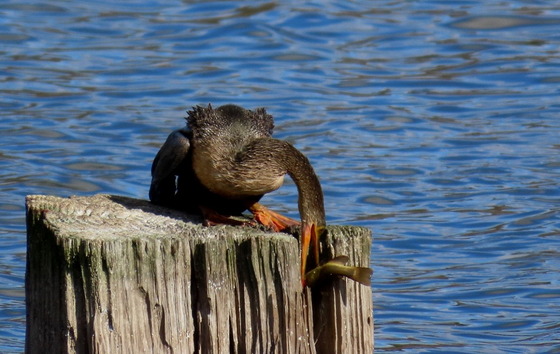 Anhinga nabs fish a second time (Bob Sargent/DNR)
DNR Program Manager Dr. Bob Sargent spotted this anhinga with a catfish while leading a birding trip at Harris Neck National Wildlife Refuge during the Georgia Ornithological Society’s winter meeting. While these encounters don’t usually end well for the fish, for a moment this one seemed in doubt. The anhinga climbed the stump with its catch, but the catfish wriggled free and fell into the water. The anhinga immediately dove in and within seconds nabbed the fish and returned to the stump. The catfish did slither away again. But this time it became wedged in a split in the stump. Game over.
CREDIT
Masthead: bee (Marcia Brandes/GNPA)
Top
|